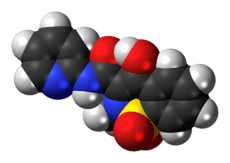Piroxicam
 | |
 | |
| Clinical data | |
|---|---|
| Trade names | Feldene and many others[1] |
| AHFS/Drugs.com | Monograph |
| MedlinePlus | a684045 |
| Pregnancy category |
|
| Routes of administration | Oral |
| ATC code | M01AC01 (WHO) M02AA07 (WHO), S01BC06 (WHO) |
| Legal status | |
| Legal status | |
| Pharmacokinetic data | |
| Protein binding | 99%[2] |
| Metabolism | Liver-mediated hydroxylation and glucuronidation[2] |
| Biological half-life | 50 hours[2] |
| Excretion | Urine, faeces |
| Identifiers | |
| |
| CAS Number |
36322-90-4 |
| PubChem (CID) | 5280452 |
| IUPHAR/BPS | 7273 |
| DrugBank |
DB00554 |
| ChemSpider |
10442653 |
| UNII |
13T4O6VMAM |
| KEGG |
D00127 |
| ChEBI |
CHEBI:8249 |
| ChEMBL |
CHEMBL527 |
| ECHA InfoCard | 100.048.144 |
| Chemical and physical data | |
| Formula | C15H13N3O4S |
| Molar mass | 331.348 g/mol |
| 3D model (Jmol) | Interactive image |
| |
| |
| (verify) | |
Piroxicam /paɪˈrɒksɪˌkæm/ (INN, BAN, USAN, AAN; in some countries it is spelt piroksikam or piroxikam) is a non-steroidal anti-inflammatory drug (NSAID) of the oxicam class used to relieve the symptoms of painful, inflammatory conditions like arthritis.[2][3] Piroxicam works by preventing the production of a certain type of body chemical called prostaglandins which are involved in the mediation of pain, stiffness, tenderness and swelling.[2] The medicine is available as capsules, tablets and (not in all countries) as a prescription-free gel 0.5%.[4] It is also available in a betadex formulation, which allows a more rapid absorption of piroxicam from the digestive tract.[2]
It was originally brought to market by Pfizer under the tradename Feldene in 1980, became generic in 1992,[5] and is marketed worldwide under many brandnames.[1]
Medical uses
It used in the treatment of rheumatoid and osteoarthritis, primary dysmenorrhoea, postoperative pain; and act as an analgesic, especially where there is an inflammatory component.[2] The European Medicines Agency issued a review of its use in 2007 and recommended that its use be limited to the treatment of chronic inflammatory conditions, as it only in these circumstances that its risk-benefit ratio proves to be favourable.[4][6]
Adverse effects
As with other NSAIDs the principal side effects include: digestive complaints like nausea, discomfort, diarrhoea and bleeds or ulceration of the stomach, as well as headache, dizziness, nervousness, depression, drowsiness, insomnia, vertigo, hearing disturbances (such as tinnitus), high blood pressure, oedema, light sensitivity, skin reactions (including, albeit rarely, Stevens-Johnson syndrome and toxic epidermal necrolysis) and rarely, kidney failure, pancreatitis, liver damage, visual disturbances, pulmonary eosinophilia and alveolitis.[4] Compared to other NSAIDs it is more prone to causing gastrointestinal disturbances and serious skin reactions.[4]
Mechanism of action
Piroxicam is an NSAID and, as such, is a non-selective COX inhibitor possessing both analgesic and antipyretic properties.[4]
Chemical properties
Piroxicam exists as enol tautomer in organic solvents and as zwitterionic form in water.[7]
History
The project that produced piroxicam began in 1962 at Pfizer; the first clinical trial results were reported in 1977, and the product launched in 1980 under the brand name "Feldene".[5][8] Major patents expired in 1992[5] and the drug is marketed worldwide under many brandnames.[1]
See also
References
- 1 2 3 Drugs.com Drugs.com international listings for piroxicam Page accessed July 3, 2015
- 1 2 3 4 5 6 7 Brayfield, A, ed. (14 January 2014). "Piroxicam". Martindale: The Complete Drug Reference. London, UK: Pharmaceutical Press. Retrieved 24 June 2014.
- ↑ "TGA Approved Terminology for Medicines, Section 1 – Chemical Substances" (PDF). Therapeutic Goods Administration, Department of Health and Ageing, Australian Government. July 1999: 97.
- 1 2 3 4 5 Joint Formulary Committee (2013). British National Formulary (BNF) (65 ed.). London, UK: Pharmaceutical Press. pp. 665, 673–674. ISBN 978-0-85711-084-8.
- 1 2 3 Lombardino JG, Lowe JA 3rd. The role of the medicinal chemist in drug discovery--then and now. Nat Rev Drug Discov. 2004 Oct;3(10):853-62. PMID 15459676. See: Box 1: Discovery of piroxicam (1962–1980)]
- ↑ "COMMITTEE FOR MEDICINAL PRODUCTS FOR HUMAN USE (CHMP) OPINION FOLLOWING AN ARTICLE 31(2) REFERRAL PIROXICAM CONTAINING MEDICINAL PRODUCTS" (PDF). European Medicines Agency. London, UK: European Medicines Agency. 20 September 2007. Retrieved 24 June 2014.
- ↑ Ivanova D, Deneva V, Nedeltcheva D, Kamounah FS, Gergov G, Hansen PE, Kawauchi S, Antonov L (2015). "Tautomeric transformations of piroxicam in solution: a combined experimental and theoretical study". RSC Advances. 5: 31852–31860. doi:10.1039/c5ra03653d.
- ↑ Weintraub M, Jacox RF, Angevine CD, Atwater EC (1977). "Piroxicam (CP 16171) in rheumatoid arthritis: a controlled clinical trial with novel assessment techniques". Journal of Rheumatology. 4 (4): 393–404. PMID 342691.